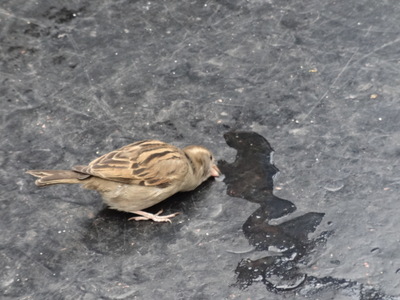
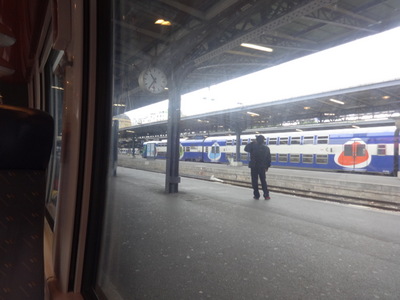 . . . with the result that on the appointed day, we got to the Gare de l'Est way early—10 minutes earlier, and we could have caught the previous train (they run hourly).
. . . with the result that on the appointed day, we got to the Gare de l'Est way early—10 minutes earlier, and we could have caught the previous train (they run hourly).Thursday, 21 June, Vaux le Vicomte and Hélène Darroz
Written 29 July 2018
Back in the days before I kept on-line travel diaries, we spent a few days in Paris with Rachel Sinnett and number one son Henry Sinnett, in honor of his bar mitzvah. One of our major excursions was to a château near Melun called Vaux le Vicomte (literally "Viscount Vales"), which came highly recommended by Parisian friend Françoise Favre, who used to take her students there when she was resident director of the Smith College junior year abroad program. "C'est un bijou," she said, "un bijou!" And she was right. The day was blistering hot, and restoration of the château was in its early stages, but we had an excellent tour and a great lunch and even explored the gardens a little before the sun drove us back indoors.
Vaux was built by Nicolas Fouquet, finance minister to Louis XIV (probably with money embezzled from the royal treasury, but that's another story). Fouquet had terrific taste and was a patron of the arts. He was a patron of Molière and La Fontaine, both of whom spent time in residence there, and the gardens are by Le Nôtre. Fouquet was justifiably proud of the place and invited Louis XIV to the party and fireworks display marking its completion. Louis like it so much, in fact was furiously angry and green with envy that it wasn't his, that he went right out and built the Château de Versailles, determined that nobody should have a house that outshown his own.
When we visited with Rachel and Henry, getting there was a production. You had to take the train from Paris's Gare de Lyon to Melun, then get a taxi to the château, which was a good long way away. Today, it's much easier. You get the "P" commuter train from Paris's Gare de l'Est (just two metro stops from our place) to Verneuil l'Etang, where each train is met by Châteaubus, a dedicated shuttle bus (10 euro round trip) that serves both Vaux and another local castle. Furthermore, the shuttle then takes you back to Verneuille just in time to get the train back to Paris. The train and bus schedules are listed right on the château's website, so you no longer have to research train schedules yourself and, at the end of the day, find a way to call a taxi to come get you from Melun (French taxis charge from when they leave to pick you up, not from the time you get aboard). You can even reserve your bus trip in advance.
This year, I wanted to go back, now that the restoration is complete and the gardens have had a chance to grow up a little. And this year, the improved transportation possibilities were made even easier by our transport passes, which were good anywhere in the Isle de France, which includes Vaux—no need to look up the fares, deal with purchasing tickets live or through a vending machine; just show up and swipe the card (and have cash ready for the shuttle bus).
The château's website goes on at length about reserving in advance during the busy season, lest, e.g, the shuttle bus should be full, but I had no way of printing advance tickets, and June shouldn't be the the very busy season, and we weren't going to one of the more popular events (like the nighttime tour by candle light), so we decided to wing it. We chose a day when the railroads weren't scheduled to be on strike, and I took the metro up to the Gare de l'Est one morning before David got up, to see how long it took, make sure we knew where everything was and how to catch the train, etc. . . .

 . . . with the result that on the appointed day, we got to the Gare de l'Est way early—10 minutes earlier, and we could have caught the previous train (they run hourly).
. . . with the result that on the appointed day, we got to the Gare de l'Est way early—10 minutes earlier, and we could have caught the previous train (they run hourly).
Once we'd looked around and made sure we knew where everything was, we settled at one of the station's coffee shops for a hot chocolate. (I blush, but yes, it was a Starbuck's, and no, our American Starbucks gift card wasn't good there, but the clerk gave us a discount anyway.) A large sign advertised the new sandwich options Starbucks had just introduced. Now, it's an American-based company, so you'd think they'd have a better idea of American foodways than most, but no—their new "Louisiana club sandwich" was touted as containing Cajun-spiced chicken, cheddar, and onion jam, all topped off with curry sauce!
A busy colony of sparrows (Passer domesticus, our "English sparrow" or "house sparrow"; native to Europe, but an invasive pest in North America) was foraging among the tables. This thirsty female was drinking from a puddle of what I hope was water near our table.
When we'd finished our chocolate, and our train had finally appeared on the electronic board revealing which track it would be on, we swiped our transport cards at the gate and waited on the mostly deserted platform for it to roll in.
The train was mostly empty, too. The half-hour train ride was pleasant enough, and the bus was waiting, as promised, right outside the station. No problem with overcrowding—it was just us and a half-dozen French tourists with their guide. The 20-minute ride to the castle took us through a couple of small villages and fields of the usual maize and colza (oil-seed rape).
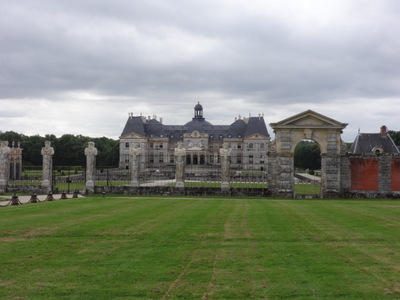
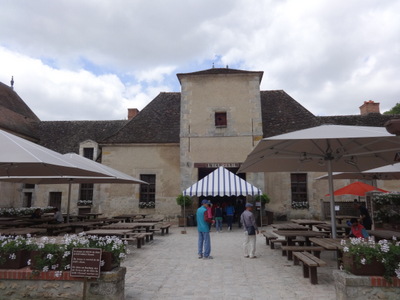 Here's the view of the castle, through its iron fence and gate, from the bus parking lot. Also in the parking lot was a sign assuring us that the castle's forests were certrified as being sustainably managed.
Here's the view of the castle, through its iron fence and gate, from the bus parking lot. Also in the parking lot was a sign assuring us that the castle's forests were certrified as being sustainably managed.
We got there just at lunch time, so we went straight to the castle's cafeteria/grill (not in the castle itself but in one of the many stone barns, stables, and outbuildings), which is called l'Ecureuil, "the Squirrel," because Fouquet's family crest featured a squirrel.
The brown sign in front says that only the grill's customers may sit at the shaded tables on this terrace. Again, there was plenty of room.
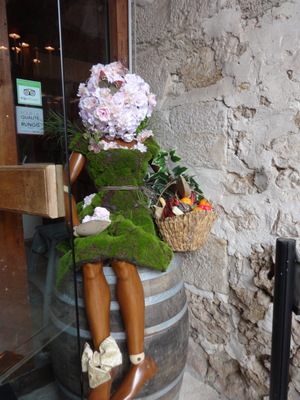
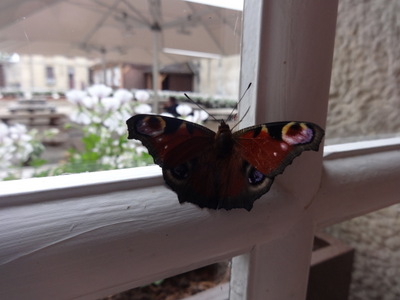 The entrance was flanked by a pair of these charming little mannequins, about the size of real little girls.
The entrance was flanked by a pair of these charming little mannequins, about the size of real little girls.
The arms and legs are wooden, and the skirt and bodice are real, living moss. The fruits, vegetables, and ivy in her basket are artificial, as are the butterflies. The roses forming her head probably were, too, but I didn't look closely.
On the other hand, this large, handsome skipper, trying to get out through a window by our table, was real. My book of European insects tells me that it is Inachis (or Aglais
?) io, the common, widespread, and un mistakable "paon du jour," or "daytime peacock." It was more brightly colored than my photo shows.While we were choosing our table, a group of a couple dozen people came in that included a guy in a wheelchair. The tables that had been reserved for them were upstairs in the loft. No elevator was provided, so the restaurant provided its alternative accommodation, which consisted of the manager and two waiters, who carried him up the stairs, chair and all.
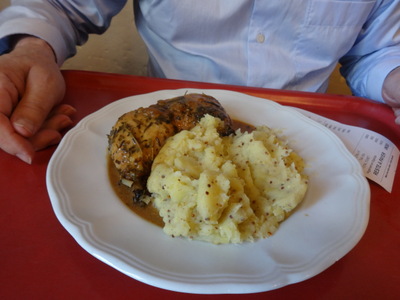
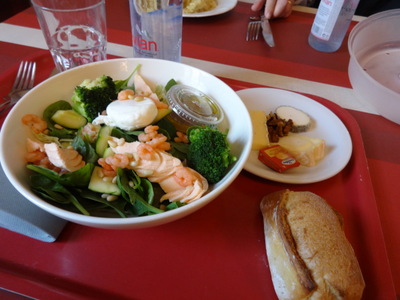 David chose the host dish of the day, tarragon chicken, which came with mashed potatoes liberally laced with whole-grain mustard.
David chose the host dish of the day, tarragon chicken, which came with mashed potatoes liberally laced with whole-grain mustard.
I had one of their ready-made salads: greens, baby spinach, poached salmon, tiny cooked shrimp, cucumber, broccoli, pine nuts, and a poached egg. Vinaigrette on the side. I also got bread and a cheese plate, consisting of slices of Brie, Pont l'Éveque (I think), and St. Maur, accompanied by a few walnuts and a single-serve packet of butter. David tried the St. Maur, which was the standard rather dry ashed version, but he didn't like it as well as the fresh St. Maur of a few evenings earlier.
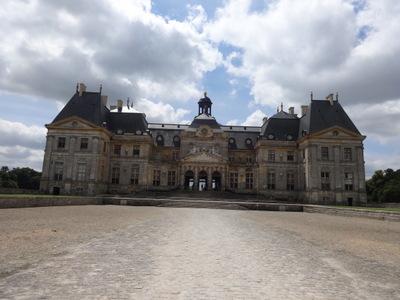
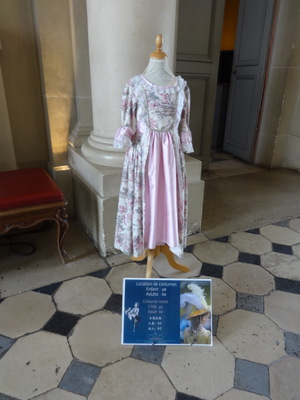 Here's a view of the castle's façade from inside the fence, about halfway from the fence to the front door. Behind us, lawns stretch to the gate, and to the right and left were large stone and brick stable blocks. The ones to our right house a large museum of carriages, but we didn't have time to cover that. This view shows the famous "transparence": as you look in the front doors, you can see straight through the entrance hall and the grand rotunda and out the glass doors of the other side to the gardens. Still between us and the castle is the ornamental moat well stocked with large carp. Le Nôtre was a master of the suddenly revealed feature—things like ditches, moats, and water features that you don't see until you're upon them.
Here's a view of the castle's façade from inside the fence, about halfway from the fence to the front door. Behind us, lawns stretch to the gate, and to the right and left were large stone and brick stable blocks. The ones to our right house a large museum of carriages, but we didn't have time to cover that. This view shows the famous "transparence": as you look in the front doors, you can see straight through the entrance hall and the grand rotunda and out the glass doors of the other side to the gardens. Still between us and the castle is the ornamental moat well stocked with large carp. Le Nôtre was a master of the suddenly revealed feature—things like ditches, moats, and water features that you don't see until you're upon them.
Just inside, in the main entrance hall, one can rent child's period costumes, like this little pink dress, for kids who really want to get into the experience. We encountered several school groups having tours, all the boys equipped with wooden swords and the girls with hats, shawls, and whatnot. During the tour, we could look out windows and see pairs of little boys who had broken away from their groups having at each other with wooden swords.
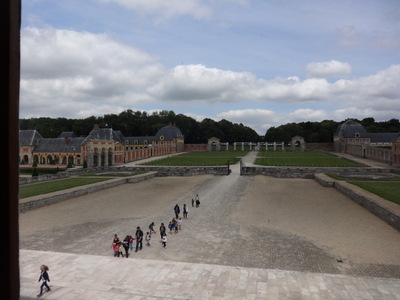
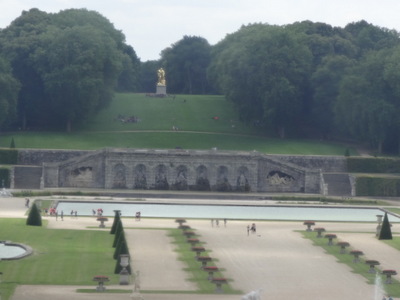 This shot from an upstairs window shows the view back the way we came in. An arriving school group is crossing the parvis toward the front door. To the sides, you can see the stable blocks. The cafeteria/grill is behind the one at the left here. If the single walker in the lower left corner turned 90 degrees to her right and advanced a few steps, she would encounter the moat.
This shot from an upstairs window shows the view back the way we came in. An arriving school group is crossing the parvis toward the front door. To the sides, you can see the stable blocks. The cafeteria/grill is behind the one at the left here. If the single walker in the lower left corner turned 90 degrees to her right and advanced a few steps, she would encounter the moat.
At the right is an upstairs telephoto view of the "back yard." From the house, even the second floor, you seem to be able to walk the length of the central avenue, go around the little rectangular pool, and approach the row of stone arches (and their decorative grottos), but in fact, between the pool and the arches, is another of Le Nôtre's hidden features—a wide "canal" stretching far to each side. From its near edge, the arches are still 200 yards away!
The conical green things are living topiary evergreens, and the mushroom-shaped objects are round stone planters on pedestals, filled with pink flowers.
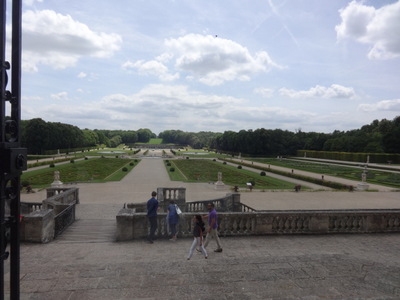
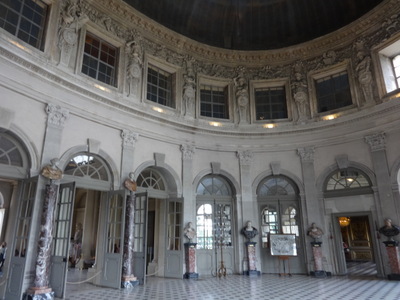 This nontelephoto view closer to ground level from the back doors of the grand rotunda (which is, of course, under the central dome) gives a better idea of the scale involved. From here, you can just make out the rectangular pool, row of arches, and green hillside beyond them.
This nontelephoto view closer to ground level from the back doors of the grand rotunda (which is, of course, under the central dome) gives a better idea of the scale involved. From here, you can just make out the rectangular pool, row of arches, and green hillside beyond them.
Broad lawns also stretched out to both sides of the house. One of them sported an arrangement of life-size bronze elk.
At the right is a partial view of the rotunda. The busts around the periphery are of Roman emporers, each labeled with name and dates of birth, death, and emperorship. They aren't painted, but they're polychrome in the sense that the togas are made of a material different from the head and neck, and they clasps or jewelry of yet another material. Between the two in the middle of the photo, you can make out the curclicued brass foot of a tall, round Christmas-tree-shaped metal frame that bears eight tiers of little glass cups, which I suspect hold candles for the night-time tours.
The black-and-white checked marble floor has lines etched into it that serve as a sundial/calendar when sun shines in the doors.
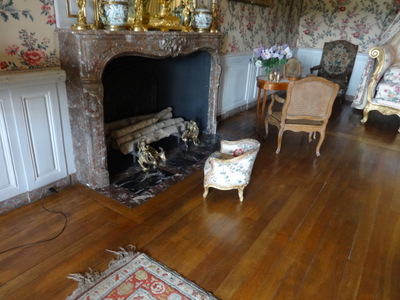
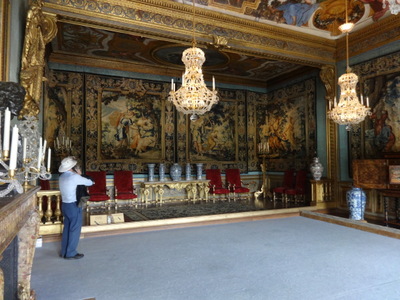 The audio-self-guided tour included many rooms, upstairs and down, filled with period furnishings (and some furnishings, especially portraits, that actually belonged to the Fouquets and their successors as owners of the house (not long after the house was completed, Louis had Fouquet thrown in prison and the house later passed to others). I'll include only a few shots. The one at the left here included this charming little child-sized chair in front of the fireplace.
The audio-self-guided tour included many rooms, upstairs and down, filled with period furnishings (and some furnishings, especially portraits, that actually belonged to the Fouquets and their successors as owners of the house (not long after the house was completed, Louis had Fouquet thrown in prison and the house later passed to others). I'll include only a few shots. The one at the left here included this charming little child-sized chair in front of the fireplace.
The one at the right was lined with magnificent tapestries and had a gorgeous ceiling.
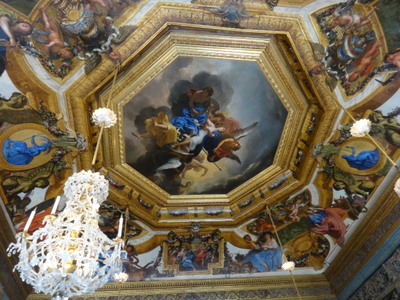
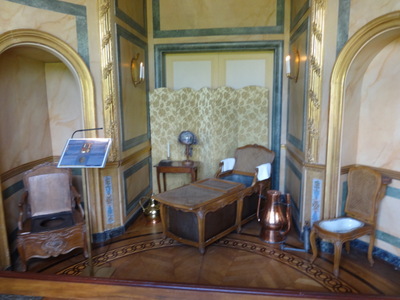 Here, at the left, is one view of the gorgeous ceiling. I wasn't able to get all of it into one photo.
Here, at the left, is one view of the gorgeous ceiling. I wasn't able to get all of it into one photo.
At the right is a lady's bathroom (that of the Duchesse du Villars, whose husband owned the castle from 1705 until his heir sold it in 1764). It includes, left to right, the discretely named "pierced chair," a blue stanchion that is not part of the decor but bears a description of it, a bathtub with a sliding cover and an arm-chair back (white towels are draped over the arms), a tall copper kettle from which extra hot water to could be poured into the bath, and a chair with a china basin set in the seat (presumably a bidet).
Only rooms in the basement and on the main floor and second floor have been furnished and restored. The third floor housed the servants, and we also had the opportunity (of which we did not avail ourselves) to climb a million stairs up into the rafters of the dome, should we wish to study the architecture or see the view.
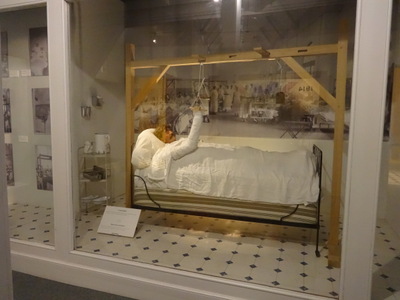
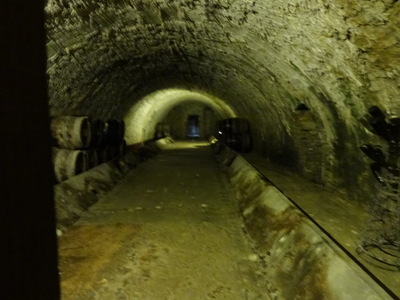 During the first world war, the castle was used as a hospital, and the displays include many paintings and photographs from that era, as well as portraits, correspondence, and biographies of many of the staff. A framed list of everyone who was a patient here hangs on one wall. The image at the left here is of a life-size diorama of a patient in bed with his broken right arm hanging from a sling. A blow-up of a period photo of the nursing staff forms the background.
During the first world war, the castle was used as a hospital, and the displays include many paintings and photographs from that era, as well as portraits, correspondence, and biographies of many of the staff. A framed list of everyone who was a patient here hangs on one wall. The image at the left here is of a life-size diorama of a patient in bed with his broken right arm hanging from a sling. A blow-up of a period photo of the nursing staff forms the background.
At the right is a view into the wine cellar, now empty except for a few barrels at the left. We passed it on our way to the basement kitchens, always my favorite part of such a tour.
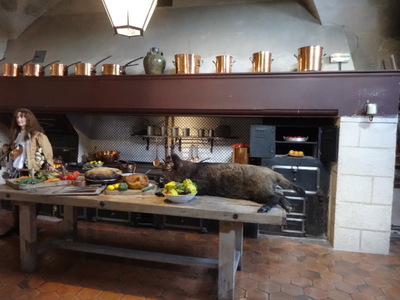
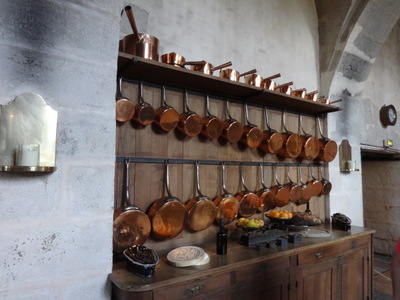 In front of the main stove was this large wooden kitchen table laden with raw materials, starting with a wild boar (presumably a product of the taxidermist's art), presided over by a mannequin dressed as a servant.
In front of the main stove was this large wooden kitchen table laden with raw materials, starting with a wild boar (presumably a product of the taxidermist's art), presided over by a mannequin dressed as a servant.
On another wall was this impressive array of copper saucepans and skillets (another rack held long rows of lids of all sizes). On the shelf below them are a couple of ceramic terrines, a Brie de Meaux (the lid of its box ajar), and bowls of fruit resting on an iron balance scale.
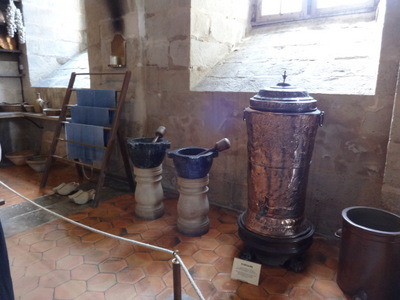
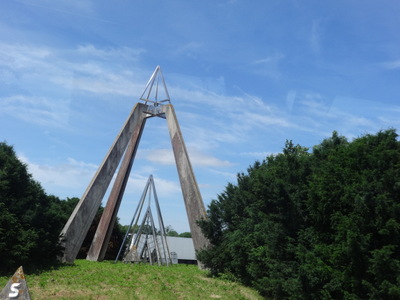 Here, at the left, you see a wooden drying rack with a pair of wooden shoes underneath, a couple of very large mortar-and-pestle sets, a large picklng crock (at the right-hand side), and a tall copper "fountain"—that is, an urn that some small boy was no doubt charged with keeping full of water drawn from whatever source the castle used, so that the cooks could always have running water at need, from the little tap near the bottom.
Here, at the left, you see a wooden drying rack with a pair of wooden shoes underneath, a couple of very large mortar-and-pestle sets, a large picklng crock (at the right-hand side), and a tall copper "fountain"—that is, an urn that some small boy was no doubt charged with keeping full of water drawn from whatever source the castle used, so that the cooks could always have running water at need, from the little tap near the bottom.
Alas, all too soon, and way before we had seen everything, we had to set out back across the parvis toward the parking lot to catch our bus back to Verneuil. In France, every highway rotary has something large and distinctive in the center, so that drivers can readily tell them apart amid all the similar-looking fields and villages. This one, which we passed both coming and going, was marked by this tall, elegant metal pyramid, presumably a work of art rather than, say, a working windmill or oil well.
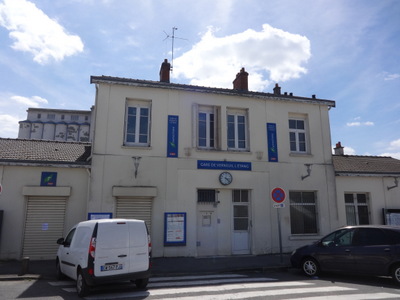
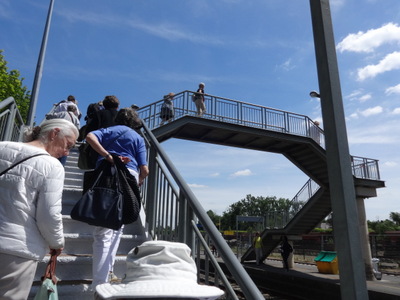 The bus driver seemed rather more on edge on the return trip, because, as he pointed out, if he runs into a traffic jam or other hold-up coming from the station, the castle will still be there if he's five minutes late. The same is not true in the other direction, where the train will not wait for him. So he was pretty strict about departure times, and kept the pedal to the metal whenever feasible.
The bus driver seemed rather more on edge on the return trip, because, as he pointed out, if he runs into a traffic jam or other hold-up coming from the station, the castle will still be there if he's five minutes late. The same is not true in the other direction, where the train will not wait for him. So he was pretty strict about departure times, and kept the pedal to the metal whenever feasible.
At the left here is the Verneuil l'&Eactue;tang train station, from the street side. We passed around it (rather than through it, which surprised me—nobody looked at our passes at any point) to find that to reach the other side of the tracks (since the train would be coming from the other direction this time), we had to climb up and over this pedestrian overpass.
Once again, very inaccessible. This is a commuter train. Does noone who work in Paris, live in Verneuil, and use a wheelchair? Getting up and over that thing would be an constant headache. Even if three stout porters were on hand to carry a wheelchair, it's three fee straight down from the platform to the tracks, and back up again on the other side. Not easy. It seems to me a simple matter to construct and mount a light-weight wooden or metal drawbridge that could be cranked down to span the tracks long enough for somebody to roll across, then cranked back up out of the way. I wonder whether that option is available anywhere?
As it happened, we were at the station in plenty of time for the train, and the train got us back to Paris in plenty of time for our evening dinner reservations. The whole trip went off much more smoothly than I feared.
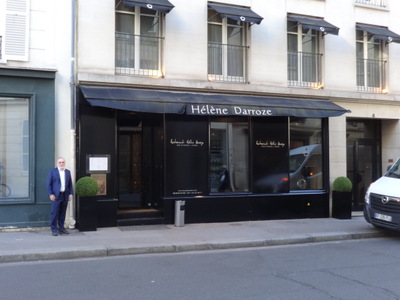
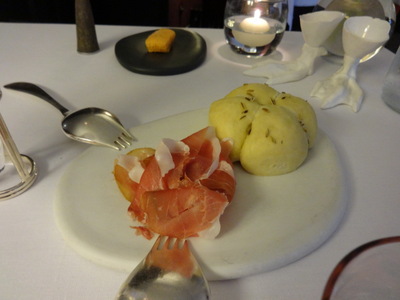 Our reservations were at Hélène Darroze, where we've eaten once before. In fact, she's from a restaurant family from Langon, and we've eaten at the family place there as well.
Our reservations were at Hélène Darroze, where we've eaten once before. In fact, she's from a restaurant family from Langon, and we've eaten at the family place there as well.
The amuse-bouche was a warm carraway-seed-topped bun with ham, sliced on the spot with a huge shiny mechanical slicer, on which a whole boneless raw ham is permanently installed. In the photo, you can also see the butter flavored with piment d'espelette, and the strange pair of china goose feet, with little cups on top. I have no idea what they were for.
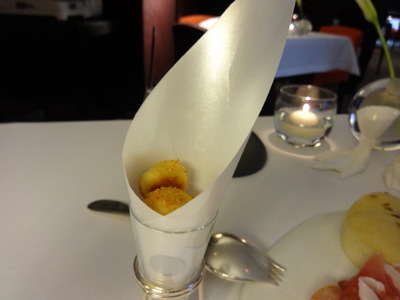
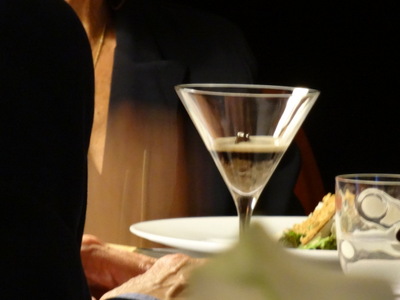 With the ham, we were also served a cone of tiny, warm gougères.
With the ham, we were also served a cone of tiny, warm gougères.
ordered the eight-course tasting menu, so for several courses we ate the same things. The first was oysters with "corn beans" (them again), and caviar. It was served in a martini glass, oysters in the bottom, bean purée on top, and caviar on top of that (in turn topped with that annoying metal foil, silver this time). We ate ours before I remembered to take a photo, but I was able to telephoto this image off a neighboring table, when it was served to them later.
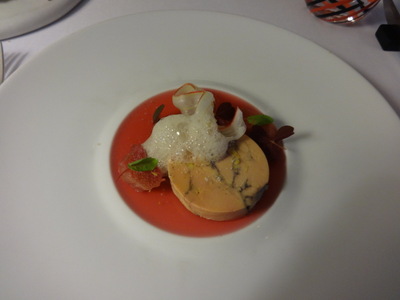
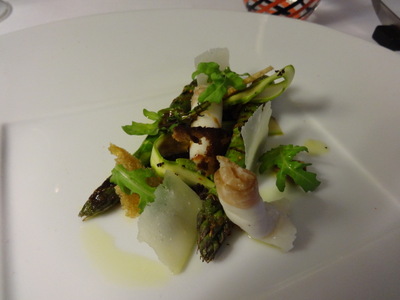 Second course: foie gras, with Maydie (a liqueur), rhubarb, yogurt, and lemon. The foie gras was a cold terrine. The rhubarb appeared both as a stout cross section of stem and as a long, streaked ribbon. And of course, everything ws garnished with Oxalis. Very good.
Second course: foie gras, with Maydie (a liqueur), rhubarb, yogurt, and lemon. The foie gras was a cold terrine. The rhubarb appeared both as a stout cross section of stem and as a long, streaked ribbon. And of course, everything ws garnished with Oxalis. Very good.
Third course: green asparagus, accompanied by Taggiasche olives, Reggiano Parmsan, arugula, and beef juice.
Each course was labeled with the name and region of the supplier who provided the main ingredient.
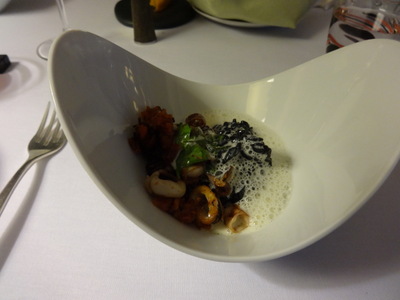
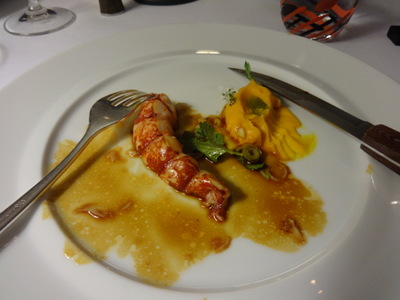 Fourth course: chipirons, i.e. baby squid, with black rice (whether inherently black or colored with squid ink, I'm not sure), chorizo, parsley, and more Parmesan. I think the Parmesan must have been in the foam.
Fourth course: chipirons, i.e. baby squid, with black rice (whether inherently black or colored with squid ink, I'm not sure), chorizo, parsley, and more Parmesan. I think the Parmesan must have been in the foam.
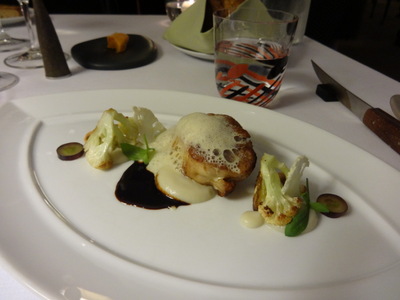
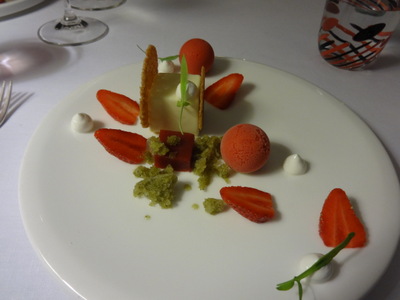 Sixth course: a choice between veal sweetbreads and pigeon, but the pigeon was for two people and entailed another supplement. I really wanted the sweetbreads, so David graciously went along (he's come a long way over the years). The sweetbreads came with roasted and puréed cauliflower, hazelnuts, and vadouvan. They were delicious, but the chef must really have gone easy on the vadouvan, as it was barely detectable. When I made a batch of it once, it took days and dozens of washings to get the (admittedly deliciously appetizing) smell off my hands.
Sixth course: a choice between veal sweetbreads and pigeon, but the pigeon was for two people and entailed another supplement. I really wanted the sweetbreads, so David graciously went along (he's come a long way over the years). The sweetbreads came with roasted and puréed cauliflower, hazelnuts, and vadouvan. They were delicious, but the chef must really have gone easy on the vadouvan, as it was barely detectable. When I made a batch of it once, it took days and dozens of washings to get the (admittedly deliciously appetizing) smell off my hands.
Seventh course: strawberries. Gariguettes, fresh, and in the froms of sorbetsand fruit paste, garnished with chopped pistachios and tiny crispy meringues and accompanied by a little cube of cheesecake and basil. The cheesecake was good but bore virtually no resemblance to American cheesecake, so I asked the waiter what kind of cheese it was made from. He had to stop and think to remember the name—an American thing, he said, called Philadelphia. Who knows what they did to or with it.
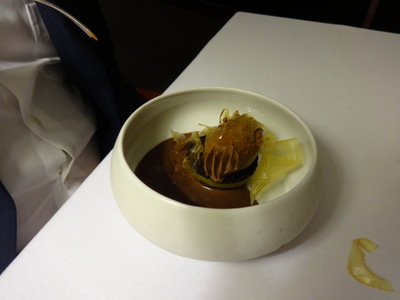
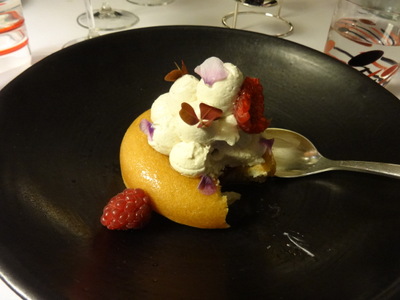 Eighth course: a choice between chocolate with passion fruit and the restaurant's signature savarin with armagnac, raspberry, and pepper. We got one of each.
Eighth course: a choice between chocolate with passion fruit and the restaurant's signature savarin with armagnac, raspberry, and pepper. We got one of each.
David's chocolate took the form of a little chocolate sandwich with passion-fruit cream inside, chocolate sauce underneath, and a puff of chocolate on top, the whole garlished with crisp sheets of shiny clear passion-fruit candy.
A savarin is basically a ring-shaped baba au rhum. Mine was flavored (not too strongly, fortunately) with Armagnac and filled with puff of whipped cream (presumably lightly peppered, although I didn't notice it), a few raspberries, a few rose petals, and the ever-present Oxalis leaves. Tasty!
The mignardises were of no great interest—little cookies and cakes— but were served on a handsome silver rack, each on its own little suspended dish.
Previous entry List of Entries Next entry